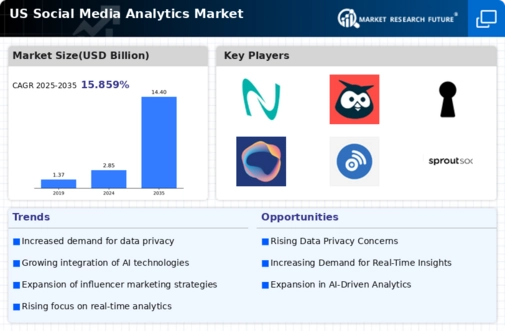Expansion of Social Media Platforms
The proliferation of social media platforms is a key driver of the social media-analytics market. With new platforms emerging and existing ones evolving, businesses are presented with an ever-expanding array of data sources. In 2025, it is anticipated that the number of active social media users in the US will reach approximately 250 million, creating a vast pool of data for analysis. This expansion compels organizations to adopt advanced analytics tools to capture and interpret user interactions across various platforms. Consequently, the social media-analytics market is likely to witness robust growth as companies seek to harness insights from diverse social media channels to enhance their marketing efforts.
Rising Demand for Data-Driven Insights
The social media-analytics market is experiencing a notable surge in demand for data-driven insights. Businesses are increasingly recognizing the value of leveraging social media data to inform strategic decisions. In 2025, it is estimated that companies utilizing social media analytics will see a 30% increase in customer engagement. This trend is driven by the need for organizations to understand consumer behavior and preferences, enabling them to tailor their marketing strategies effectively. As a result, the social media-analytics market is projected to grow significantly, with a compound annual growth rate (CAGR) of 25% over the next five years. This growth reflects a broader shift towards data-centric approaches in business operations.
Integration of Advanced Analytics Tools
The integration of advanced analytics tools into marketing strategies is significantly influencing the social media-analytics market. Businesses are increasingly adopting sophisticated technologies such as predictive analytics and sentiment analysis to gain deeper insights into consumer behavior. In 2025, it is projected that the market for advanced analytics tools will grow by 40%, reflecting a shift towards more nuanced data interpretation. This trend enables organizations to make informed decisions based on predictive models, enhancing their ability to engage with customers effectively. As a result, the social media-analytics market is likely to expand as companies seek to leverage these advanced tools for competitive advantage.
Growing Importance of Influencer Marketing
The rise of influencer marketing is emerging as a significant driver for the social media-analytics market. Brands are increasingly collaborating with influencers to reach targeted audiences, necessitating the use of analytics to measure campaign effectiveness. In 2025, it is estimated that influencer marketing will account for 15% of total marketing budgets for many companies. This shift highlights the need for robust analytics to assess the impact of influencer partnerships on brand visibility and consumer engagement. Consequently, the social media-analytics market is expected to grow as businesses seek to optimize their influencer marketing strategies through data-driven insights.
Increased Focus on Brand Reputation Management
In the current landscape, managing brand reputation has become paramount for businesses, driving growth in the social media-analytics market. Companies are increasingly utilizing analytics to monitor brand sentiment and public perception in real-time. As of 2025, it is estimated that 70% of businesses will invest in social media analytics tools specifically for reputation management. This trend underscores the importance of understanding consumer feedback and addressing potential crises proactively. By leveraging social media analytics, organizations can enhance their brand image and foster customer loyalty, thereby contributing to the overall expansion of the market.
























Leave a Comment